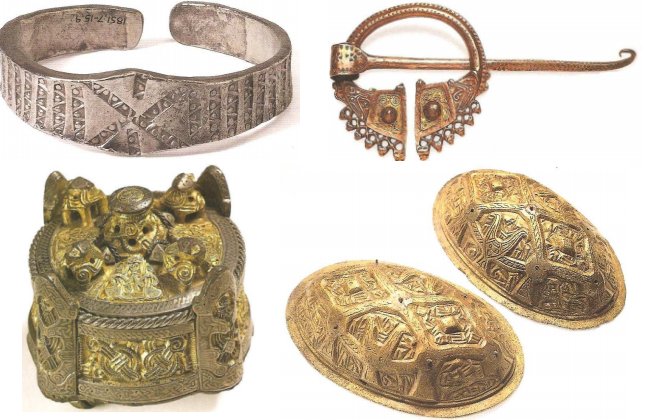MessageToEagle.com – Astonishing Norse jewelry discovered in hoards and burial sites reveal Vikings were highly skilled craftsmen. Viking jewelry was beautifully made and it’s still reproduced today in modern times.
Ancient Viking jewelry was in most cases made of silver or bronze and sometimes gold. Many Viking ornaments featured images of animals, particularly twisting shapes of snakes.
Viking jewelry showed status and wealth
Both men and women loved wearing jewelry such as rings, brooches, bracelets and necklace. It was a sign of their wealth and status in the society.
Poor people often made jewelry from bronze, pewter or old animal bones. The Vikings made all their tools themselves and everyone was expected to master wrought iron as well wood. Being a craftsman was very popular during the Viking Age. There was always work and demand for skilled craftsmen.
How was ancient Viking jewelry created?
The Vikings created jewelry by making a wax mold and pouring melted metal into it. The wax mold was broken once the metal had cooled and the piece was buffed until it shone. This is called the “lost wax” method. Early in their history the Norse jewelry was very simple but later the Vikings created beautiful, intricate pieces.
The Vikings picked up jewelry fashions from other countries and later changed them to their own style.
Jewelry was often used as currency
It was a common practice to use jewelry as a form of currency.
Vikings wore arm and neck rings, usually made of silver, from which they would hack pieces off to make payment for goods and services. This type of jewelry is referred to as hack silver.
Discovered hoards reveal extraordinary collections of Viking jewelry
With coins, spectacular arm-rings, ingots (metal bars) and lots of fragments of chopped-up pieces – known as ‘hacksilver’ – the Silverdale Hoard provided a fascinating glimpse into the history of the Vikings in Lancashire.
A massive 1,000-year-old Viking hoard, known as the Watlington Hoard unearthed by a metal detectorist in a field in Oxfordshire, UK contained 186 coins, seven items of jewelry and 15 ingots. Around 1989 21 silver arm rings were unearthed near Huxley in Cheshire County England by Steve Reynoldson who made the discovery with his metal detector. Many of the rings were decorated with an intricate diagonal cross design and a few are unfinished. All were flattened down before being buried. It is believed that these pieces were to be melted down and reused or used for trade. The arm rings are believed to be from the first decade of the 10th century AD.
Viking jewelry was worn by both men and women
Vikings decorated almost all kinds of things, including swords, clothing, ships and houses. Jewelry was worn for adornment and for displaying wealth. It was also a means of exchange and used to seal friendships and alliances.
Arm rings and neck rings were very popular, but finger rings were rarely worn before the late Viking Age. Earrings were hardly worn at all. The most common item of Scandinavian Viking Age jewelry was women’s bronze oval brooches. Necklaces were often hung with souvenirs (odd items picked up from abroad) such as coins and finger rings.
See also:
Runes: Facts And History About Odin’s Secret Language
10 Great Viking Misconceptions Still Being Perpetuated
Unravelling The Mystery Of The Ulfberht Sword – An Ancient Viking Artifact Far Ahead Of Its Time
Swinegate Finds: Young Viking Era Woman Buried Beneath Lost Church Could Have Lived 999 Years Ago
An odd characteristic of Viking jewelry was its nearly total lack of set stones. The Hon Necklace is a famous necklace, found in a hoard discovered at Hon, Norway, and dated to the 9th century. This was an extremely rare find, since Viking hoards normally contained mostly silver objects. The Hon hoard, in contrast, contained mostly objects of gold.
Last, we should mention that Thor’s Hammer was nearly always worn as pendants.
Copyright © MessageToEagle.com. All rights reserved. This material may not be published, broadcast, rewritten or redistributed in whole or part without the express written permission of MessageToEagle.com
References:
Graham-Campbell, James- The Viking World
Wilson, David M.- The Vikings and Their Origins
Margeson, Susan M,- Eyewitness Viking
Fitzhugh, William W.- Vikings: The North Atlantic Saga








